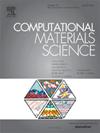光滑边界法改进了物理气相沉积过程中平面衬底表面和蚀刻坑表面薄膜生长动力学的相场模型
IF 3.3
3区 材料科学
Q2 MATERIALS SCIENCE, MULTIDISCIPLINARY
引用次数: 0
摘要
本文提出了一种光滑边界法修正相场模型,用于模拟物理气相沉积过程中平面衬底表面和蚀刻坑表面薄膜的生长动力学。这种方法有效地捕获了薄膜生长和衬底拓扑结构之间复杂的相互作用,为薄膜的微观结构演变和力学性能提供了见解。晶粒生长消耗、扩散和对流等控制机制之间的竞争导致了薄膜表面的不均匀。数值结果表明,在平面基底上生长薄膜时,θi角较大的晶粒最终被θi角较小的晶粒所消除。结果表明,随着入射蒸汽通量速度的增加,在定义的特征区域S内的最终孔隙度增大,而最终孔隙度随着入射蒸汽通量的增加而减小。对于蚀坑表面的柱状晶粒生长,最终孔隙率与长径比、入射蒸汽通量速度和入射蒸汽通量密切相关。本文章由计算机程序翻译,如有差异,请以英文原文为准。

Smoothed boundary method modified phase-field modeling of growth dynamics of thin films on the surface of the planar substrate and the etch pit during physical vapor deposition
In this paper, we present a smoothed boundary method modified phase-field model for simulating the growth dynamics of thin films on the surface of the planar substrate and the etch pit during physical vapor deposition. This method effectively captures the complex interactions between film growth and substrate topology, providing insights into the microstructural evolution and mechanical properties of the films. The competition among the governing mechanisms such as the consumption of the grain growth, diffusion, and convection results in the unevenness of the film surface. Numerical results demonstrate that the grains with larger grain-dependent angle are eventually eliminated by the ones with lower for the thin film growth on a planar substrate. It was found that the increase of the incident vapor flux velocity leads to the increase of the final porosity in the defined characteristic region S while the final porosity decreases with the increase of the incident vapor flux. For the columnar grain growth on the surface of the etch pit, the final porosity strongly depends on the aspect ratio, the incident vapor flux velocity, and the incident vapor flux.
求助全文
通过发布文献求助,成功后即可免费获取论文全文。
去求助
来源期刊

Computational Materials Science
工程技术-材料科学:综合
CiteScore
6.50
自引率
6.10%
发文量
665
审稿时长
26 days
期刊介绍:
The goal of Computational Materials Science is to report on results that provide new or unique insights into, or significantly expand our understanding of, the properties of materials or phenomena associated with their design, synthesis, processing, characterization, and utilization. To be relevant to the journal, the results should be applied or applicable to specific material systems that are discussed within the submission.
 求助内容:
求助内容: 应助结果提醒方式:
应助结果提醒方式:


